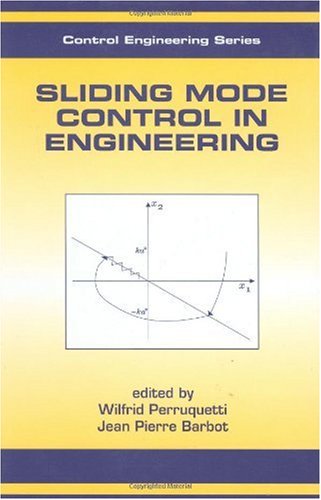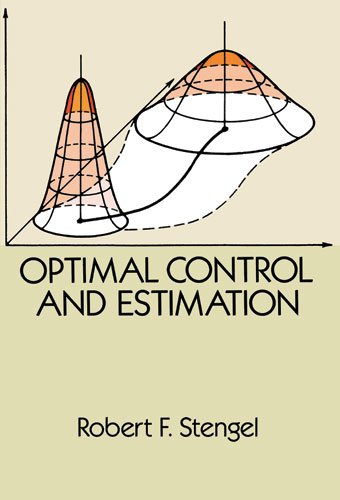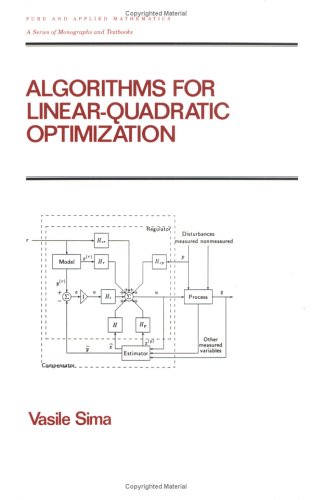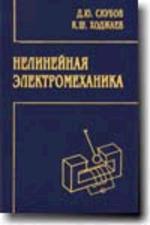Wilfrid Perruquetti0824706714, 9780824706715
Table of contents :
SLIDING MODE CONTROL IN ENGINEERING……Page 1
Series Introduction……Page 4
Preface……Page 6
Contributors……Page 17
Contents……Page 10
1.1 Introduction and historical account……Page 20
Contents……Page 0
1.2 An introductory example……Page 23
1.3.1 Linear systems……Page 26
1.3.2 Nonlinear systems……Page 30
1.3.3 The chattering phenomenon……Page 31
1.4.1 Reachability condition……Page 33
1.4.2 Robustness properties……Page 36
1.5.1 Trajectory following……Page 40
1.5.2 Model following……Page 41
1.6 Conclusion……Page 43
References……Page 44
2.1 Introduction……Page 47
2.2 Discontinuous differential equations and differential inclusions……Page 49
2.3 Differential inclusions and Filippov solutions……Page 51
2.4 Viability and equivalent control……Page 57
2.5 Robustness and discontinuous control……Page 62
2.6 Numerical treatment……Page 65
2.7 Mathematical appendix……Page 66
2.8 Bibliographical comments……Page 67
References……Page 68
3.1 Introduction……Page 70
3.2.1 Sliding modes on manifolds……Page 73
3.2.2 Sliding modes with respect to
constraint functions……Page 74
3.3.1 Ideal sliding……Page 76
3.3.2 Real sliding and finite time convergence……Page 79
3.4 Higher order sliding stability in
relay systems……Page 81
3.4.1 2-sliding stability in relay systems……Page 82
3.5.1 Stability of 2-sliding modes in systems
with fast actuators……Page 83
3.5.2 Systems with fast actuators of relative
degree 3 and higher……Page 86
3.6.1 2-sliding dynamics……Page 91
3.6.2 Twisting algorithm……Page 93
3.6.3 Sub-optimal algorithm……Page 95
3.6.4 Super-twisting algorithm……Page 97
3.6.5 Drift algorithm……Page 98
3.6.6 Algorithm with a prescribed convergence law……Page 99
3.7 Arbitrary-order sliding controllers……Page 101
3.7.2 Controller construction……Page 104
3.7.3 Examples……Page 109
References……Page 113
4.1 Introduction……Page 119
4.2 Preliminary example……Page 121
4.3.1 Nonlinear observer……Page 122
4.3.2 Sliding observer for output and output derivative nonlinear injection form……Page 124
4.4 Triangular input observer form……Page 129
4.4.1 Sliding mode observer design for triangular input observer form……Page 130
4.4.2 Observer matching condition……Page 134
4.5 Simulations and comments……Page 135
4.7.1 Proof of Proposition 39……Page 139
4.7.2 Proof of Theorem 41……Page 140
4.7.3 Proof of Theorem 49……Page 141
References……Page 142
5.1 Introduction……Page 147
5.2 Static output feedback of uncertain systems……Page 149
5.3 Output feedback sliding mode control for uncertain systems via dynamic compensation……Page 156
5.3.1 Dynamic compensation (observer based)……Page 159
5.3.2 Control law construction……Page 161
5.3.3 Design example……Page 164
5.4 Dynamic sliding mode control for nonlinear systems……Page 166
5.4.1 Design example……Page 173
5.5 Conclusions……Page 176
References……Page 177
6.1 Introduction……Page 179
6.2 The permanent magnet stepper motor……Page 180
6.2.1 The simpler D-Q nonlinear model of the PM stepper motor……Page 181
6.2.3 A passivity canonical model of the PM stepper motor……Page 182
6.2.4 A controller based on “energy shaping plus damping injection”……Page 183
6.2.6 A dynamic passivity plus flatness based controller……Page 185
6.2.7 Simulation results……Page 186
6.2.8 A pulse width modulation implementation……Page 189
6.3 The “boost” DC-to-DC power converter……Page 191
6.3.1 Flatness of the “boost” converter……Page 192
6.3.2 Passivity properties through flatness……Page 193
6.3.3 A passivity-based sliding mode controller……Page 194
6.3.5 Trajectory planning……Page 197
6.3.6 Simulation results……Page 198
6.3.7 Dc-to-ac power conversion……Page 199
6.3.8 An iterative procedure for generating a suitable inductor current reference……Page 200
6.3.9 Simulation results……Page 202
References……Page 204
7.1 Introduction……Page 206
7.2 Notation……Page 208
7.3.1 Obtention of the regular form……Page 209
7.3.2 Effect of perturbations on the regular form……Page 212
7.4.1 Problem formulation……Page 214
7.4.2 Sliding domain and initial domain of sliding motion……Page 215
7.4.3 Application……Page 217
7.5.1 Stabilization in the case d = m……Page 220
7.5.2 Stabilization in the case d > m……Page 223
7.6 Conclusion……Page 226
References……Page 227
8.1 Introduction……Page 231
8.2 Mathematical recalls……Page 232
8.3 Classical sliding modes in discrete time……Page 235
8.4 Second-order sliding mode under sampling……Page 239
8.5 The sampled “twisting algorithm”……Page 243
References……Page 244
9.1 Introduction……Page 247
9.2 Identification of continuous linear systems in I/O form……Page 249
9.3 MRAC model reference adaptive control……Page 252
9.3.1 MRAC with accessible states……Page 253
9.3.2 Adaptive control for SISO plant in I/O form: an introductory example with relative degree equal to one……Page 255
9.3.3 Generalization to system of relative degree greater than one……Page 260
9.4 Sliding mode and adaptive control……Page 261
9.5 Combining sliding mode with adaptive control……Page 263
9.6 Conclusions……Page 273
References……Page 274
10.1 Introduction……Page 276
The simplest example of steady modes……Page 277
Statement of the problem……Page 278
10.2.1 Steady modes……Page 279
10.2.2 Stability……Page 281
10.3.1 Existence of stable zero frequency periodic steady modes for a singularly perturbed multidimensional system……Page 282
10.3.2 Existence of stable zero frequency steady modes in systems of arbitrary order……Page 284
10.4.1 Stabilization of the simplest unstable system……Page 285
10.4.2 Stable systems with bounded perturbation and relay controllers with delay……Page 286
10.4.3 Statement of the adaptive control problem……Page 287
10.4.4 The case of definite systems……Page 288
10.5.2 Systems and steady modes of the second order……Page 289
10.5.3 Stability and instability of steady modes for multidimensional case……Page 290
10.7 Appendix: proofs……Page 291
References……Page 303
11.1 Introduction……Page 307
11.2.1 Problem formulation……Page 310
11.2.2 A case study……Page 311
11.2.3 An example with simulation……Page 314
11.3.1 Regular form……Page 318
11.3.2 Asymptotic stability of systems with small delays……Page 319
11.3.3 Sliding mode controller synthesis……Page 320
11.3.4 Example: delay in the state……Page 327
11.4 Conclusion……Page 329
References……Page 331
12.1 Introduction……Page 336
Notation……Page 339
12.2 Motivation: disturbance rejection in Hilbert space……Page 340
12.3.1 Semilinear differential equation……Page 342
12.3.2 Discontinuous control input and sliding mode equation……Page 343
12.4 Unit control synthesis for uncertain systems with a finite-dimensional unstable part……Page 346
12.4.1 Disturbance rejection in exponentially stabilizable systems……Page 347
12.4.2 Disturbance rejection in minimum phase systems……Page 351
References……Page 357
13.1 Introduction……Page 361
13.2.1 Dynamics of mechanical systems……Page 363
13.2.2 Control design approach……Page 364
13.2.3 Examples……Page 368
13.3 Sliding mode for robot control……Page 375
13.3.1 Sliding mode control for a pneumatic system……Page 376
13.3.2 Sliding mode control of a hydraulic robot……Page 379
13.3.3 Simulation results……Page 380
13.4 SM observers based control……Page 382
13.4.1 Observer design……Page 383
13.4.3 Stability of observer based control……Page 386
13.4.4 Simulation results……Page 389
13.4.5 Conclusion……Page 390
13.5.1 Pneumatic actuators model……Page 391
13.5.2 Hydraulic manipulator model……Page 393
13.5.3 Proof of lemma……Page 395
References……Page 396
14.1 Introduction……Page 401
14.2 Sliding modes control……Page 402
14.3 Application to the induction motor……Page 406
14.4 Benchmark “horizontal handling”……Page 408
14.4.2 Induction motor parameters (squirrel cage rotor)……Page 409
14.5.1 Results of simulations……Page 410
14.5.2 Experimental results……Page 413
14.6 Conclusion……Page 414
References……Page 415







Reviews
There are no reviews yet.